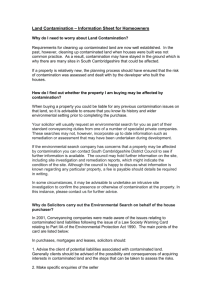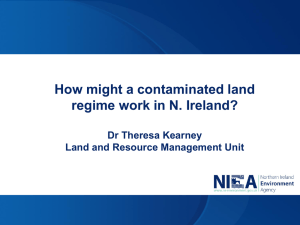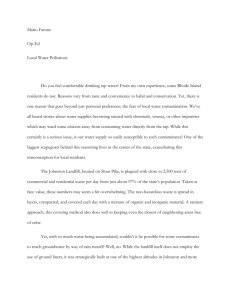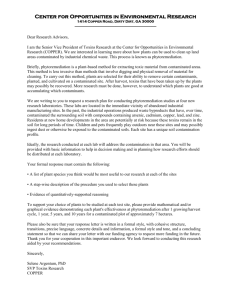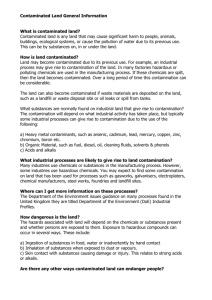From: Ashworth, George Sent: 29 March 2013 22:23 To: daniel.hay
advertisement
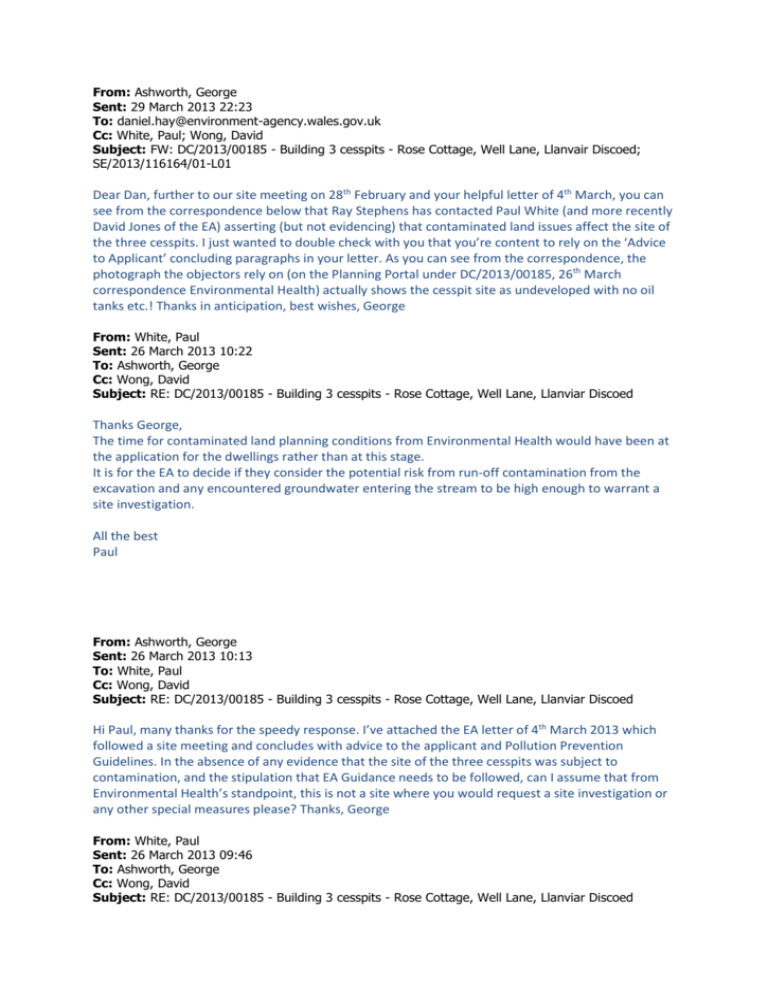
From: Ashworth, George Sent: 29 March 2013 22:23 To: daniel.hay@environment-agency.wales.gov.uk Cc: White, Paul; Wong, David Subject: FW: DC/2013/00185 - Building 3 cesspits - Rose Cottage, Well Lane, Llanvair Discoed; SE/2013/116164/01-L01 Dear Dan, further to our site meeting on 28th February and your helpful letter of 4th March, you can see from the correspondence below that Ray Stephens has contacted Paul White (and more recently David Jones of the EA) asserting (but not evidencing) that contaminated land issues affect the site of the three cesspits. I just wanted to double check with you that you’re content to rely on the ‘Advice to Applicant’ concluding paragraphs in your letter. As you can see from the correspondence, the photograph the objectors rely on (on the Planning Portal under DC/2013/00185, 26th March correspondence Environmental Health) actually shows the cesspit site as undeveloped with no oil tanks etc.! Thanks in anticipation, best wishes, George From: White, Paul Sent: 26 March 2013 10:22 To: Ashworth, George Cc: Wong, David Subject: RE: DC/2013/00185 - Building 3 cesspits - Rose Cottage, Well Lane, Llanviar Discoed Thanks George, The time for contaminated land planning conditions from Environmental Health would have been at the application for the dwellings rather than at this stage. It is for the EA to decide if they consider the potential risk from run-off contamination from the excavation and any encountered groundwater entering the stream to be high enough to warrant a site investigation. All the best Paul From: Ashworth, George Sent: 26 March 2013 10:13 To: White, Paul Cc: Wong, David Subject: RE: DC/2013/00185 - Building 3 cesspits - Rose Cottage, Well Lane, Llanviar Discoed Hi Paul, many thanks for the speedy response. I’ve attached the EA letter of 4th March 2013 which followed a site meeting and concludes with advice to the applicant and Pollution Prevention Guidelines. In the absence of any evidence that the site of the three cesspits was subject to contamination, and the stipulation that EA Guidance needs to be followed, can I assume that from Environmental Health’s standpoint, this is not a site where you would request a site investigation or any other special measures please? Thanks, George From: White, Paul Sent: 26 March 2013 09:46 To: Ashworth, George Cc: Wong, David Subject: RE: DC/2013/00185 - Building 3 cesspits - Rose Cottage, Well Lane, Llanviar Discoed Good morning George, Thanks for your response. No further evidence was provided other than the photograph and comments that an oil storage tank might have been present on site and that the land went on to be developed into a car park for the pub. Evidence of potential contamination is limited in this case and I did mention this to Robin last year when I took a call from him, however I did agree to bring it to your attention, which I did in my email to the planning email address. The purpose of a site investigation is to get an idea of the potential for contamination to be present or not. The site investigation would provide the evidence. With regard to contamination of the stream, I believe Mr Stephens was concerned with the excavated material (if contaminated) getting into the stream, through run off, rather than from contamination from the enclosed cesspits themselves. As I understand it, his experience with the contractors has not been favourable and it’s possible he is concerned about their practises and unwillingness to properly control the excavated material and run off. If the material is contaminated then it would raise another question about how it is intended to be disposed of. From Environmental Health’s perspective the risk to human health is very low, as long as the contractors exercise proper health, safety and hygiene practises. The Environment Agency would be concerned with potential surface water contamination of the stream, and as such would be the more appropriate organisation to make a decision on whether a site investigation was required or not. Kind Regards Paul From: Ashworth, George Sent: 26 March 2013 00:02 To: White, Paul Cc: Wong, David Subject: FW: DC/2013/00185 - Building 3 cesspits - Rose Cottage, Well Labne, Llanviar Discoed Hi Paul, I’ve just seen your email to David following your discussion with Ray Stephens. The email string that Ray copied to you actually ended with an email from me to Robin Yardley on 5th July 2012 which I’ve attached. You will see that in the light of the information available, I concluded by asking Robin to confirm, as a professional view, that the ‘evidence’ merited a contaminated land risk assessment. I received no further response from him, and no such confirmation. I wasn’t surprised by this, as the ‘evidence’ was the following (on page 3 of the attached emails as well as below): “As the village has no mains supply we are wholly reliant on either electric, oil or propane gas for heating. Therefore there is a significant likelihood that the site contained an oil storage tank.” On the same page, Robin went on to comment that “ A portion of the site was a commercial premises and therefore meets the definition of a ‘Brownfield Site.’” Interestingly however, the photograph he submitted showed no development whatsoever in the vicinity of Rose Cottage, and hence no justification for calling it ‘brown field’ or speculating that it may have been a location for an oil tank. I ask therefore, apart from an incomplete extract from an email string, was any evidence provided to you to support the view that the site of the three cess pits has ever suffered from contamination? If we are to potentially delay a proposal or to place onerous conditions on an applicant I’m sure you’ll agree that evidence is necessary to justify such a stance. As a final comment, I do not understand the view expressed by Ray Stephens in line 8 of your email that contamination will get into the brook. Cess pits will be entirely self-contained and will produce no flows at all, and the excavation needed for their installation will see the allegedly contaminated soil removed elsewhere! An early response would be appreciated please. Thanks and best wishes, George From: Wong, David Sent: 25 March 2013 17:38 To: Ashworth, George Subject: FW: DC/2013/00185 - Building 3 cesspits - Rose Cottage, Well Labne, Llanviar Discoed Hi George, I received this email from Paul White. From: White, Paul Sent: 20 March 2013 12:23 To: Wong, David; Planning Subject: DC/2013/00185 - Building 3 cesspits - Rose Cottage, Well Labne, Llanviar Discoed Hello David, Hope you enjoyed your leave. I have been contacted by Mr Ray Stephens and forwarded the following emails and attached photograph. He has raised his concern with me that a contaminated land site investigation was not undertaken for the development of Rose Cottage and 2 additional properties under Planning Application DC/2008/01024 on a potentially contaminated site. I emailed the planning email address about this last year (copy of the email is attached) but did not receive a reply. He is now concerned about planning application DC/2013/00185 – building 3 cesspits for the above properties. He has forwarded the above photograph which indicates that the land had a historic use that could have resulted in land contamination, and is concerned that if contamination is present it will get into the nearby stream and then into the Nedern Brook Wetlands SSSI. From reading the information provided by Mr Robin Yardley in the following emails to George Ashworth regarding potential heating oil being stored on the site and the previous commercial nature of the site and looking at the photograph it appears that there is some justification for requesting a site investigation be undertaken in the first instance prior to digging out and disposing of the soil/material. With that in mind I would recommend that if not already done so, you approach Environment Agency Wales (Natural Resources Wales) for their opinion on the matter, as they are responsible for protection of surface and groundwater from contamination and waste disposal. I can also provide you with contaminated land conditions that would cover the various site investigation and remediation stages if necessary, however the Environment Agency would provide you with their own if they consider it appropriate. Please get tin touch if you want to discuss this further From: Ray Stephens [] Sent: 20 March 2013 11:02 To: White, Paul Subject: Fw: Contaminated Land Hi Paul please see attached. Thanks Ray. ----- Forwarded Message ----From: Ray Stephens <> To: George Ashworth <georgeashworth@monmouthshire.gov.uk>; Robert Tranter <RobertTranter@monmouthshire.gov.uk>; Andrew Miller < >; james harris <jamesharris> Sent: Monday, 18 March 2013, 15:50 Subject: Fw: Contaminated Land George please see below email am I right to assume you have asked for a contaminated land assessment, as you missed this off last time, could you please confirm this will be done along with the agreed Archaeoligical watching brief ( again missed off last time). Please could you confirm, I will be speaking to Paul White contaminated land manager. ----- Forwarded Message ----From: Monkey <monkey3> To: ray.stephens Cc: dagmarvosloo; thewoodlandstavern. Sent: Wednesday, 4 July 2012, 13:31 Subject: Contaminated Land Dear George, You have stated the following in your correspondence of the 29 June 2012. “5.3 Contamination has been alleged as a problem, but was not raised during consideration of the planning application in 2009, nor used as the basis for a legal challenge. In any event, given that only part of the site was used as a pub car park for a few years, the degree of contamination is unlikely to have fallen into the ‘significant’ category that Planning Policy Wales refers to at its paragraph 13.7.2.” Paragraph 13.7.2 states the following: “Where significant contamination issues arise, the local planning authority will require evidence of a detailed investigation and risk assessment prior to the determination of the application to enable beneficial use of land. Where acceptable remedial measures can overcome such contamination, planning permission may be granted subject to conditions specifying the necessary measures. If contamination cannot be overcome satisfactorily, the authority may refuse planning permission.” However, it would appear that you have missed a significant step in the process, particularly Paragraph 13.7.1, which states that “Planning decisions need to take into account: the potential hazard that contamination presents to the development itself, its occupants and the local environment.” The most pertinent point here is the term “decisions need to take into account: the potential hazard.” There is currently no prima facia evidence that this has been a considered at all during the planning process. The issue of any potential hazard from contaminated land is unlikely to arise unless due consideration is given to it. As pointed out in my earlier correspondence (included below for completeness) apart from the commercial aspect of the site, the more significant point I raised was in relation to the storage of large quantities of fuel oil for domestic heating purposes; and the fact that this should be a material consideration in the assessment of the site. You have clearly omitted any aspect of this point within your response. Although you state that the site is just “a pub car park” this does not take account any historical legacy of any contamination. I have included a photograph of the site which indicates that there was a lot more going on at the site prior to it being a pub car park. These issues are normally addressed during the preliminary risk assessment. I look forward to your response. Yours Sincerely Robin Yardley. BEng, MSc. PS My MSc is in Contaminated Land Management and having worked on a number of rural sites which had significant issues relating to contaminated land I know enough not to pre judge a site without considering all the evidence. Dear George, As agreed in the meeting with the residents of Llanvair Discoed and Monmouthshire County Council (MCC) on the 25 May 2012, that the points raised by myself would be placed in writing. Obviously I did not want to labour the point at the meeting as these points were secondary to the main concerns raised, however, I do feel they have significant merit in there own right. (1) Contaminated Land: Having examined the information available on the MCC Planning Portal for the site it would appear that there has been no consideration given to the issue of potential contamination of the land. You were quite correct in pointing out that PPS3 (Sorry for my English centric view on that.) is not applicable to Wales, however, The Contaminated Land (Wales) Regulations 2006, Welsh Statutory Instrument 2006 No. 2989 (W.278) and subsequently through to Part 2A Statutory Guidance on Contaminated Land (2006) issued by WAG and Planning Policy Wales (2002) are applicable; as I am sure you are aware. In particular under Section 13.7 of Planning Policy Wales (2002), Development control and contaminated land, states that “Planning decisions need to take into account, the potential hazard that contamination could do both to the development itself, its occupants and the local environment”. Subject to this particular section I do feel there has been omission in the planning process in considering this issue; primarily: (a) A portion of the site was a commercial premises and therefore meets the definition of a “Brownfield Site”. (b) As the village has no mains gas supply we are wholly reliant on either electric, oil or propane gas for heating. Therefore there is a significant likelihood that the site contained an oil storage tank. Of particular interest here is the report “An analysis of inland oil and fuel incidents in England and Wales ” (Lee P, Fitzsimons D. 2005). The report discusses in some detail the environmental risks associated with domestic oil storage. (Available from the Environment Agency website). Based on a very cursory examination of the evidence, and the fact that the proposed development is residential properties with gardens, situated above an aquifer adjacent to a watercourse, we potentially have a significant Source-Pathway-Receptor linkage, which should at the very least be subject to a Preliminary Risk Assessment. I have previously undertaken contaminated land consultancy work for MCC, and one of my most significant concerns at the time was the lack of consultation between planning and your rather overstretched and under resourced Contaminated Land Officer. Is the lack of consideration of contaminated land in this proposed development a symptom of this or a systemic failure? (2) Archaeology. The Glamorgan Gwent Archaeological Trust letter dated 6 January 2009; requested that a “watching brief” be undertaken during the excavation phase of the project. I am reasonably certain that no such activity has been undertaken at the site to date. Is it logical to assume that in future this aspect of the planning condition will be implemented; and will there be any redress by the developer in this matter? I look forward to your response. Yours Sincerely Robin Yardley

